
ProactiveAgent
A LLM-based Agent that predict its tasks proactively.
Stars: 259
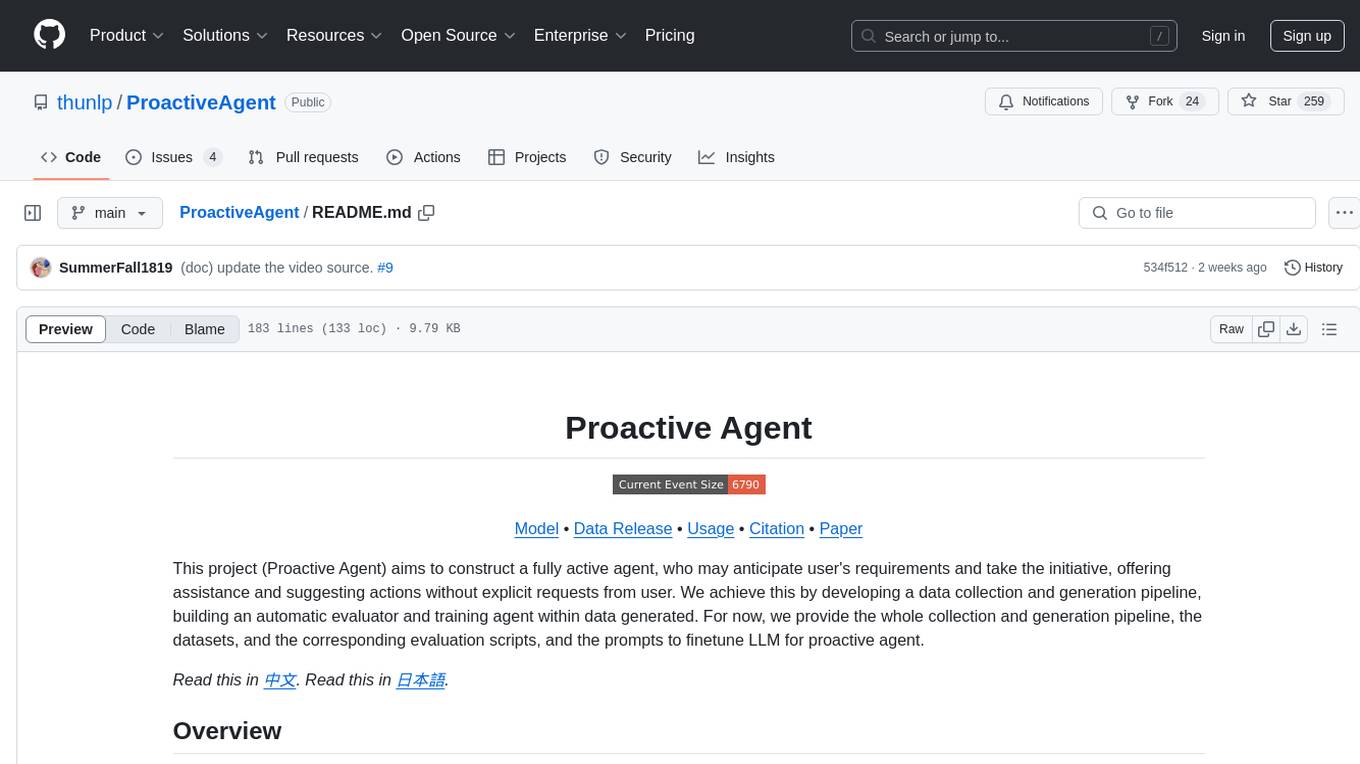
Proactive Agent is a project aimed at constructing a fully active agent that can anticipate user's requirements and offer assistance without explicit requests. It includes a data collection and generation pipeline, automatic evaluator, and training agent. The project provides datasets, evaluation scripts, and prompts to finetune LLM for proactive agent. Features include environment sensing, assistance annotation, dynamic data generation, and construction pipeline with a high F1 score on the test set. The project is intended for coding, writing, and daily life scenarios, distributed under Apache License 2.0.
README:
Model • Data Release • Usage • Citation • Paper
This project (Proactive Agent) aims to construct a fully active agent, who may anticipate user's requirements and take the initiative, offering assistance and suggesting actions without explicit requests from user. We achieve this by developing a data collection and generation pipeline, building an automatic evaluator and training agent within data generated. For now, we provide the whole collection and generation pipeline, the datasets, and the corresponding evaluation scripts, and the prompts to finetune LLM for proactive agent.
Read this in 中文. Read this in 日本語.
✨Here is an overview of the whole process of Proactive Agent.
✨✨Features:
- Environment Sensing: We provide scripts to collect environment scenes and user activities through Activity Watcher, and recommend tasks automatically based on the model.
- Assistance Annotation: We provide a platform to annotate the response generated by the proactive agent, which is a good way to align the result with human annotators.
- Dynamic Generation: We provide a dynamic pipeline to generate new data, the feedback from user could affect events afterwards.
-
Construction Pipeline: We provide a generation pipeline consist of Environment Gym, Proactive Agent and Reward Model, where our Reward Model reaches a
0.918F1 score on the test set.
A demo is also provided to show the performance of our agent.
https://github.com/user-attachments/assets/81e56660-727f-4ba8-b26c-d28b580a8b0a
In the future, we will continually improve the data quality and increase the coverage of real-world scenarios.
👐Proactive Agent is intended for coding, writing and daily life scenarios only at present and should not be constructed as reflecting the opinions or views of the creators, owners, or contributors of this dataset. It is distributed under Apache License 2.0. Below is the statistics of the data:
| Settings | Coding | Writing | Daily Life | Total |
|---|---|---|---|---|
| Inst.Num | 46 | 46 | 44 | 136 |
| Events Num | 2275 | 2354 | 2161 | 6790 |
All the training instances for the Proactive Agent were generated from our GYM. We utilize the Activity Watcher to collect the human traces across all the scenes, and annotate a test set to validate the effectiveness of the Proactive Agent. More details about the data collection and annotation can be found here.
Clone this repository and navigate to the proactive demand sensing agent folder
git clone [email protected]:thunlp/ProactiveAgent
cd ProactiveAgentInstall Package
conda create -n activeagent python=3.10
conda activate activeagent
pip install -r requirements.txt- You can go to the Official Website to download the main app based on your operating system.
- An extension for chrome is at
./agent/resource/aw-watcher-web.zip. To download this extension, you will have to download the file and unzip it.- For Edge users, go to
edge://extensions/site, open developer mode and load the extension by clickingload unpacked.` - For Google Chrome users, go to
chrome://extensions/site, open developer mode and selectload unpackedto load the unziped extension. - This Extension is not tested under
Safari.
- For Edge users, go to
- There is an official extension for vscode user, you may download it from the marketplace or search for
aw-watcher-vscodein the extensions in your vscode and install it.
To check whether the installation is complete, please open your browser and go to http://localhost:5600/#/timeline to check if there are four traces displaying in the window(afk,vscode,window,web).
You should first configure the private.toml file. The example is given in example_config.toml:
cp example_config.toml private.tomlYou should change the default_completions_model, api_key and base_url to your own settings.
To experience our proactive agent, you will first enter folder ./agent and then follow the instructions in here.
To improve the experience with the Proactive Agent, you can use our built reward model to filter the message from the Proactive Agent. Here are steps to connect the reward model with the Proactive Agent. TO BE UPDATE
Our agent will try to make a proposal by creating a toast on the window, to interact with the proactive agent, you may choose:
- Accept the proposal: you will click on the toast body(Windows) or click the button(MacOS) to let the agent know you accept his idea, the agent will make relavent actions in return.
- Reject the proposal: you will click on the dismiss button(the x on the top right of the toast) to let the agent know you reject the proposal, the agent will try to propose in some other way for next turn.
- Ignore the proposal: you will do nothing, the agent will remove the toast for some time depending on the time interval, doing nothing will make the agent know that you are busy and ignored the proposal, the agent will try to make less proposal in the following turns.
To automatic evaluate the performance of the Proactive Agent, we build a reward model based on our annotated data to judge the performance of the Proactive Agent.
Our reward model reaches a 0.918 F1 score on the test set, which is a good indicator of the performance of the Proactive Agent.
We test the agreement between the reward model and human annotators on the test set:
- Missed-Needed (MN): The scenario when the user needs help but the agent does not provide help.
- Non-Response(NR): The scenario when the user does not need help and the agent does not prompt any help.
- Correct-Detection(CD): The scenario when the user needs help and the agent provides help.
- False-Alarm(FA): The scenario when the user does not need help but the agent prompts help.
We compare the judgement of the reward model with the human annotators. We compare the performance of different LLMs and our model on the test set. The results are as follows:
| GPT-4o | GPT-4o-mini | LLaMa 3.1 8b | LLaMa 3.1 70b | ours | |
|---|---|---|---|---|---|
| Missed-Need (MN) | 0.0333 | 0.5667 | 0.8000 | 0.3333 | 0.8000 |
| Non-Response (NR) | 1.0000 | 0.5667 | 0.3000 | 0.8333 | 0.8667 |
| Correct-Detection (CD) | 1.0000 | 0.8667 | 0.9667 | 1.0000 | 1.0000 |
| False-Alarm (FA) | 0.0000 | 0.3333 | 0.1333 | 0.0667 | 1.0000 |
| Accuracy | 0.5083 | 0.5833 | 0.5500 | 0.5583 | 0.9167 |
| Precision | 0.5042 | 0.5658 | 0.5429 | 0.5340 | 0.9032 |
| Recall | 1.0000 | 0.7167 | 0.6333 | 0.9167 | 0.9333 |
| F1 | 0.6704 | 0.6324 | 0.5846 | 0.6748 | 0.9180 |
In current experiments, we evaluate the performance of the Proactive Agent with our Reward Model. We define the following metrics:
- True Positive(TP): Instances where the proactive agent correctly predicts a task that the reward model subsequently accepts.
- False Positive(FP): Instances where the proactive agent predicts a task that the reward model does not accept.
- True Negative(TN): Instances where the proactive agent correctly refrains from predicting a task,and the reward model also does not accept any task.
- False Negative(FN): Instances where the proactive agent fails to predict a task that the reward model would have accepted if proposed.
We report the performance of the Proactive Agent on the test set of the ProactiveBench.
| Model | Recall | Precision | Accuracy | False-Alarm | F1-Score |
|---|---|---|---|---|---|
| GPT-4o-mini | 100.00% | 35.28% | 36.12% | 64.73% | 52.15% |
| GPT-4o | 98.11% | 48.15% | 49.78% | 51.85% | 64.60% |
| Claude-3.5-Sonnet | 97.89% | 45.37% | 49.78% | 54.63% | 62.00% |
| LLaMA-3.1-8B | 98.86% | 38.16% | 39.06% | 61.84% | 55.06% |
| LLaMA-3.1-8B-Proactive | 99.06% | 49.76% | 52.86% | 50.24% | 66.25% |
| Qwen2-7B | 98.02% | 44.00% | 43.61% | 56.00% | 60.74% |
| Qwen2-7B-Proactive | 100.00% | 49.78% | 50.66% | 50.22% | 66.47% |
If you find this project useful in your research, please consider citing it:
@misc{2024,
author = {THUNLP},
title = {ProactiveAgent},
year = {2024},
publisher = {GitHub},
journal = {GitHub Repository},
howpublished = {\url{https://github.com/thunlp/ProactiveAgent}}
}
For Tasks:
Click tags to check more tools for each tasksFor Jobs:
Alternative AI tools for ProactiveAgent
Similar Open Source Tools

ProactiveAgent
Proactive Agent is a project aimed at constructing a fully active agent that can anticipate user's requirements and offer assistance without explicit requests. It includes a data collection and generation pipeline, automatic evaluator, and training agent. The project provides datasets, evaluation scripts, and prompts to finetune LLM for proactive agent. Features include environment sensing, assistance annotation, dynamic data generation, and construction pipeline with a high F1 score on the test set. The project is intended for coding, writing, and daily life scenarios, distributed under Apache License 2.0.
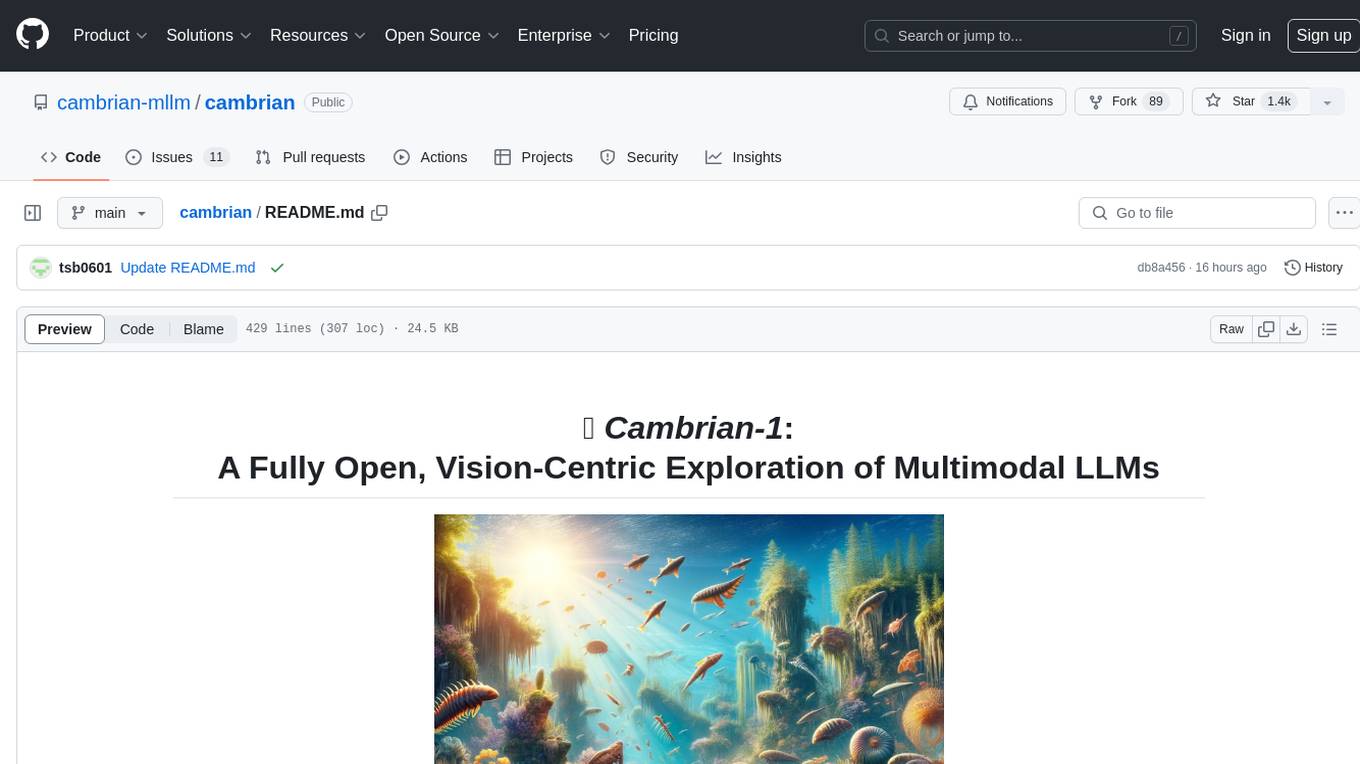
cambrian
Cambrian-1 is a fully open project focused on exploring multimodal Large Language Models (LLMs) with a vision-centric approach. It offers competitive performance across various benchmarks with models at different parameter levels. The project includes training configurations, model weights, instruction tuning data, and evaluation details. Users can interact with Cambrian-1 through a Gradio web interface for inference. The project is inspired by LLaVA and incorporates contributions from Vicuna, LLaMA, and Yi. Cambrian-1 is licensed under Apache 2.0 and utilizes datasets and checkpoints subject to their respective original licenses.
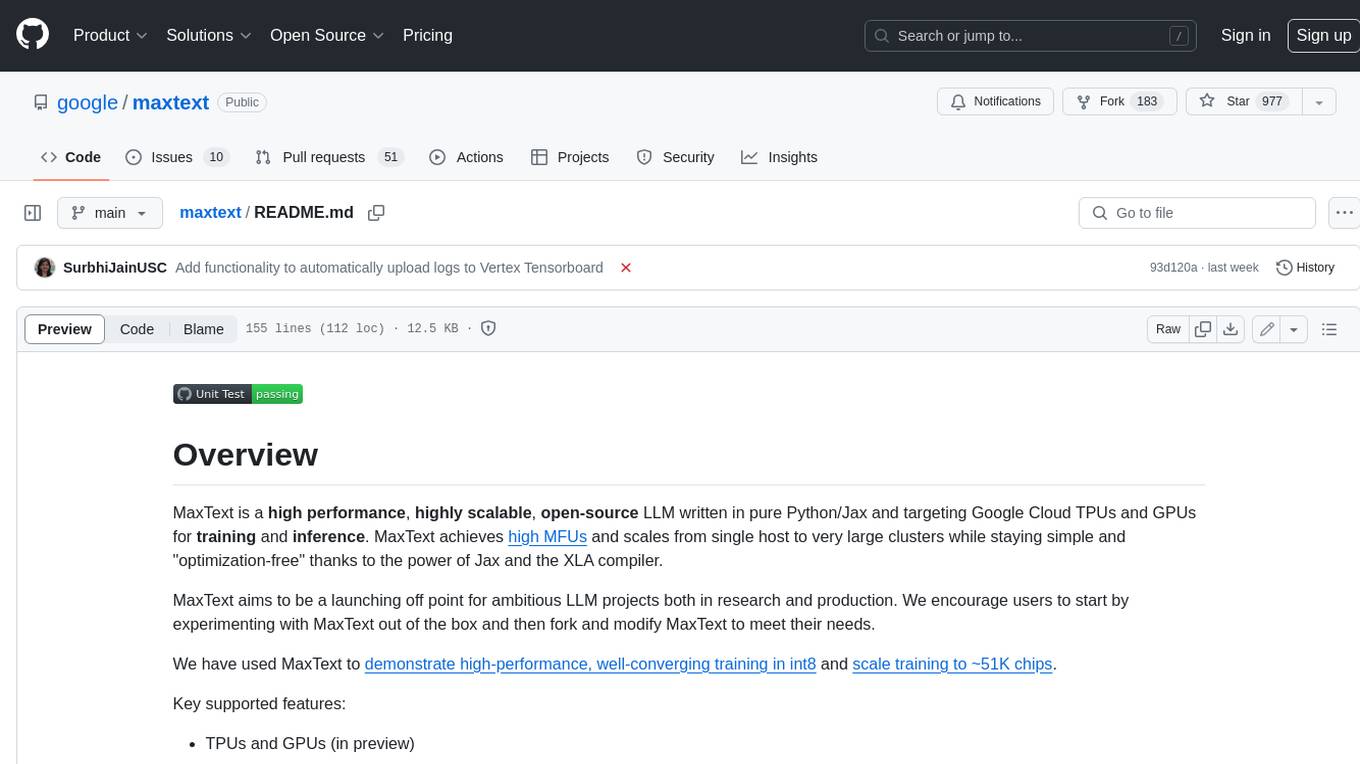
maxtext
MaxText is a high-performance, highly scalable, open-source LLM written in pure Python/Jax and targeting Google Cloud TPUs and GPUs for training and inference. MaxText achieves high MFUs and scales from single host to very large clusters while staying simple and "optimization-free" thanks to the power of Jax and the XLA compiler. MaxText aims to be a launching off point for ambitious LLM projects both in research and production. We encourage users to start by experimenting with MaxText out of the box and then fork and modify MaxText to meet their needs.
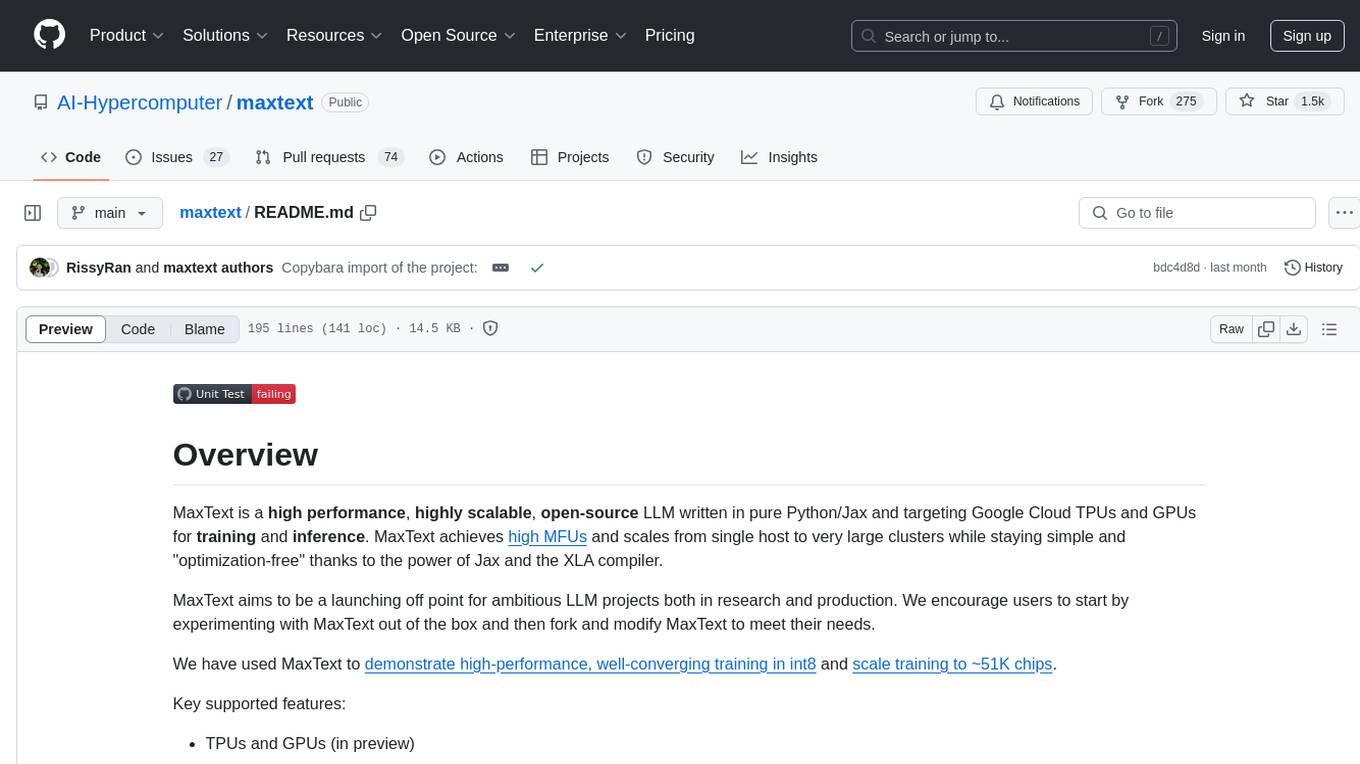
maxtext
MaxText is a high performance, highly scalable, open-source Large Language Model (LLM) written in pure Python/Jax targeting Google Cloud TPUs and GPUs for training and inference. It aims to be a launching off point for ambitious LLM projects in research and production, supporting TPUs and GPUs, models like Llama2, Mistral, and Gemma. MaxText provides specific instructions for getting started, runtime performance results, comparison to alternatives, and features like stack trace collection, ahead of time compilation for TPUs and GPUs, and automatic upload of logs to Vertex Tensorboard.
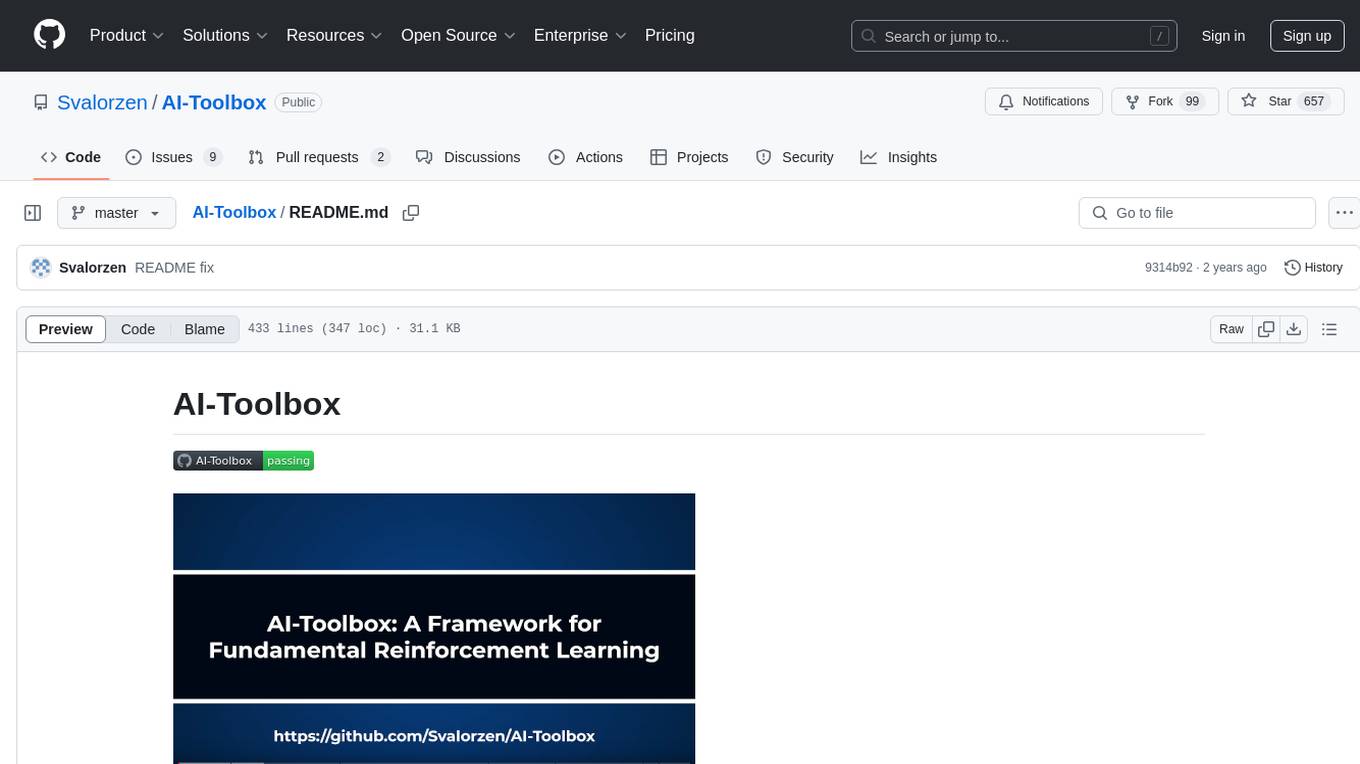
AI-Toolbox
AI-Toolbox is a C++ library aimed at representing and solving common AI problems, with a focus on MDPs, POMDPs, and related algorithms. It provides an easy-to-use interface that is extensible to many problems while maintaining readable code. The toolbox includes tutorials for beginners in reinforcement learning and offers Python bindings for seamless integration. It features utilities for combinatorics, polytopes, linear programming, sampling, distributions, statistics, belief updating, data structures, logging, seeding, and more. Additionally, it supports bandit/normal games, single agent MDP/stochastic games, single agent POMDP, and factored/joint multi-agent scenarios.
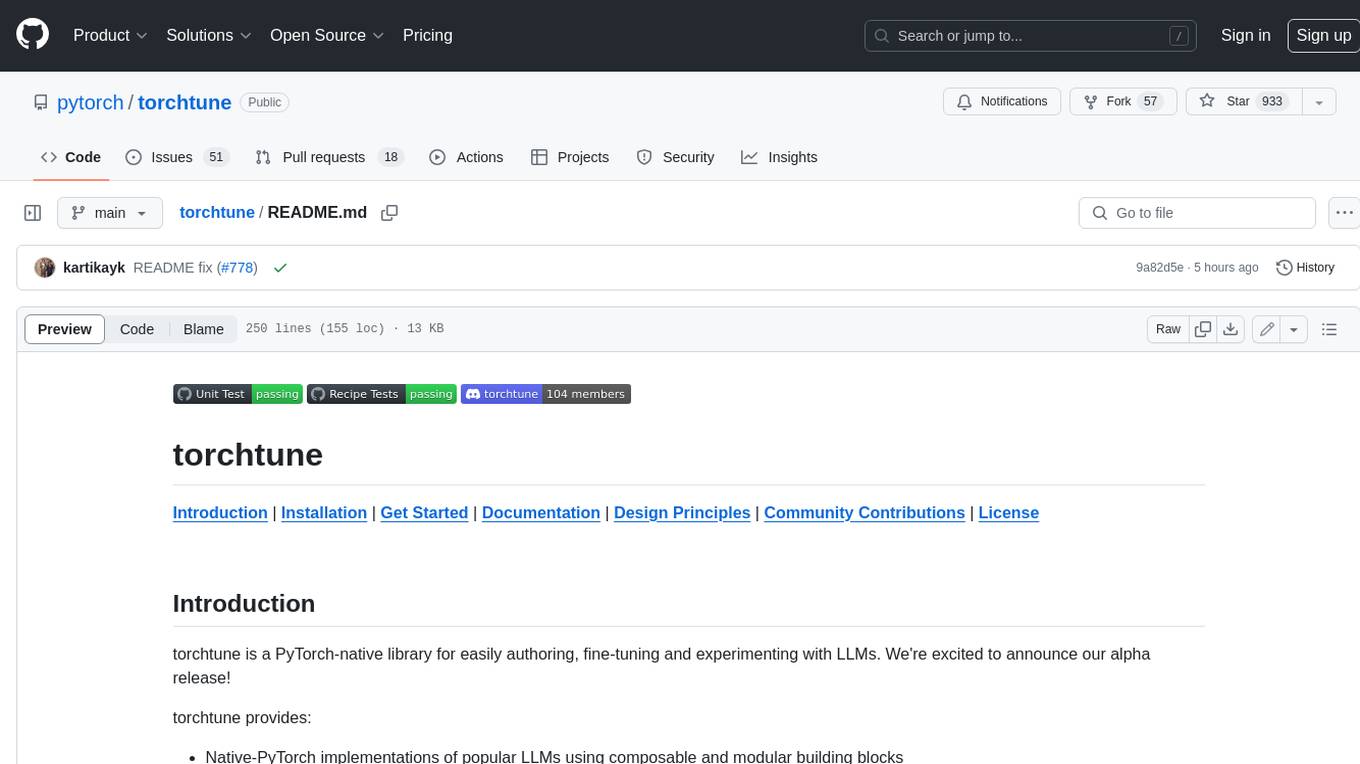
torchtune
Torchtune is a PyTorch-native library for easily authoring, fine-tuning, and experimenting with LLMs. It provides native-PyTorch implementations of popular LLMs using composable and modular building blocks, easy-to-use and hackable training recipes for popular fine-tuning techniques, YAML configs for easily configuring training, evaluation, quantization, or inference recipes, and built-in support for many popular dataset formats and prompt templates to help you quickly get started with training.
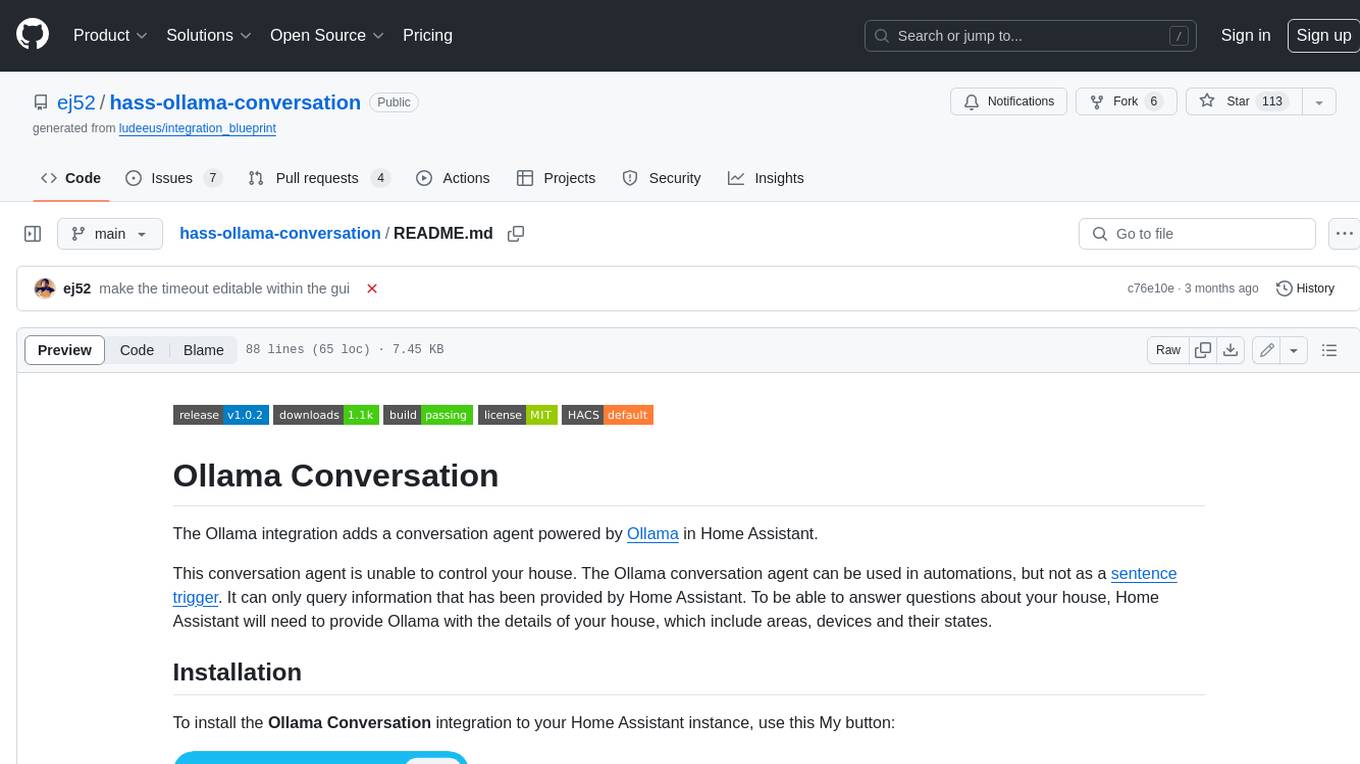
hass-ollama-conversation
The Ollama Conversation integration adds a conversation agent powered by Ollama in Home Assistant. This agent can be used in automations to query information provided by Home Assistant about your house, including areas, devices, and their states. Users can install the integration via HACS and configure settings such as API timeout, model selection, context size, maximum tokens, and other parameters to fine-tune the responses generated by the AI language model. Contributions to the project are welcome, and discussions can be held on the Home Assistant Community platform.
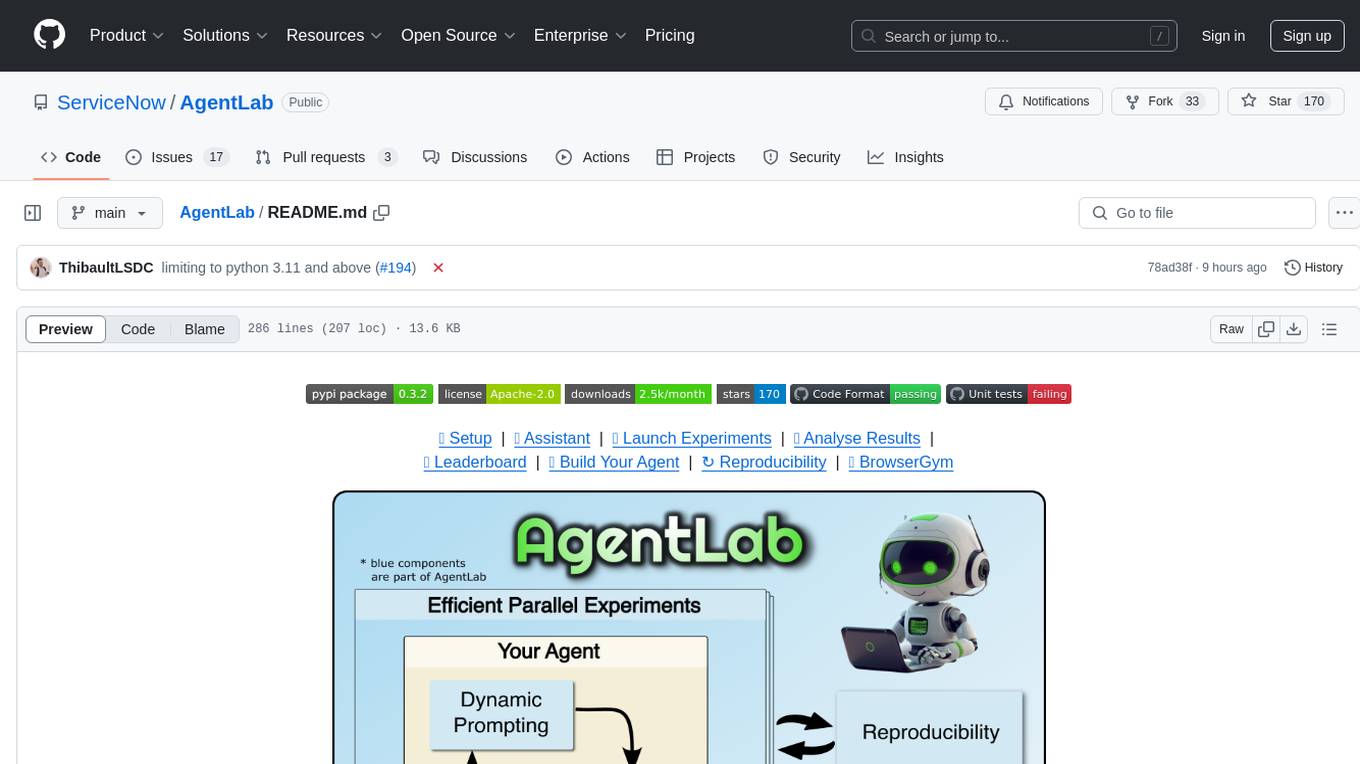
AgentLab
AgentLab is an open, easy-to-use, and extensible framework designed to accelerate web agent research. It provides features for developing and evaluating agents on various benchmarks supported by BrowserGym. The framework allows for large-scale parallel agent experiments using ray, building blocks for creating agents over BrowserGym, and a unified LLM API for OpenRouter, OpenAI, Azure, or self-hosted using TGI. AgentLab also offers reproducibility features, a unified LeaderBoard, and supports multiple benchmarks like WebArena, WorkArena, WebLinx, VisualWebArena, AssistantBench, GAIA, Mind2Web-live, and MiniWoB.

leapfrogai
LeapfrogAI is a self-hosted AI platform designed to be deployed in air-gapped resource-constrained environments. It brings sophisticated AI solutions to these environments by hosting all the necessary components of an AI stack, including vector databases, model backends, API, and UI. LeapfrogAI's API closely matches that of OpenAI, allowing tools built for OpenAI/ChatGPT to function seamlessly with a LeapfrogAI backend. It provides several backends for various use cases, including llama-cpp-python, whisper, text-embeddings, and vllm. LeapfrogAI leverages Chainguard's apko to harden base python images, ensuring the latest supported Python versions are used by the other components of the stack. The LeapfrogAI SDK provides a standard set of protobuffs and python utilities for implementing backends and gRPC. LeapfrogAI offers UI options for common use-cases like chat, summarization, and transcription. It can be deployed and run locally via UDS and Kubernetes, built out using Zarf packages. LeapfrogAI is supported by a community of users and contributors, including Defense Unicorns, Beast Code, Chainguard, Exovera, Hypergiant, Pulze, SOSi, United States Navy, United States Air Force, and United States Space Force.
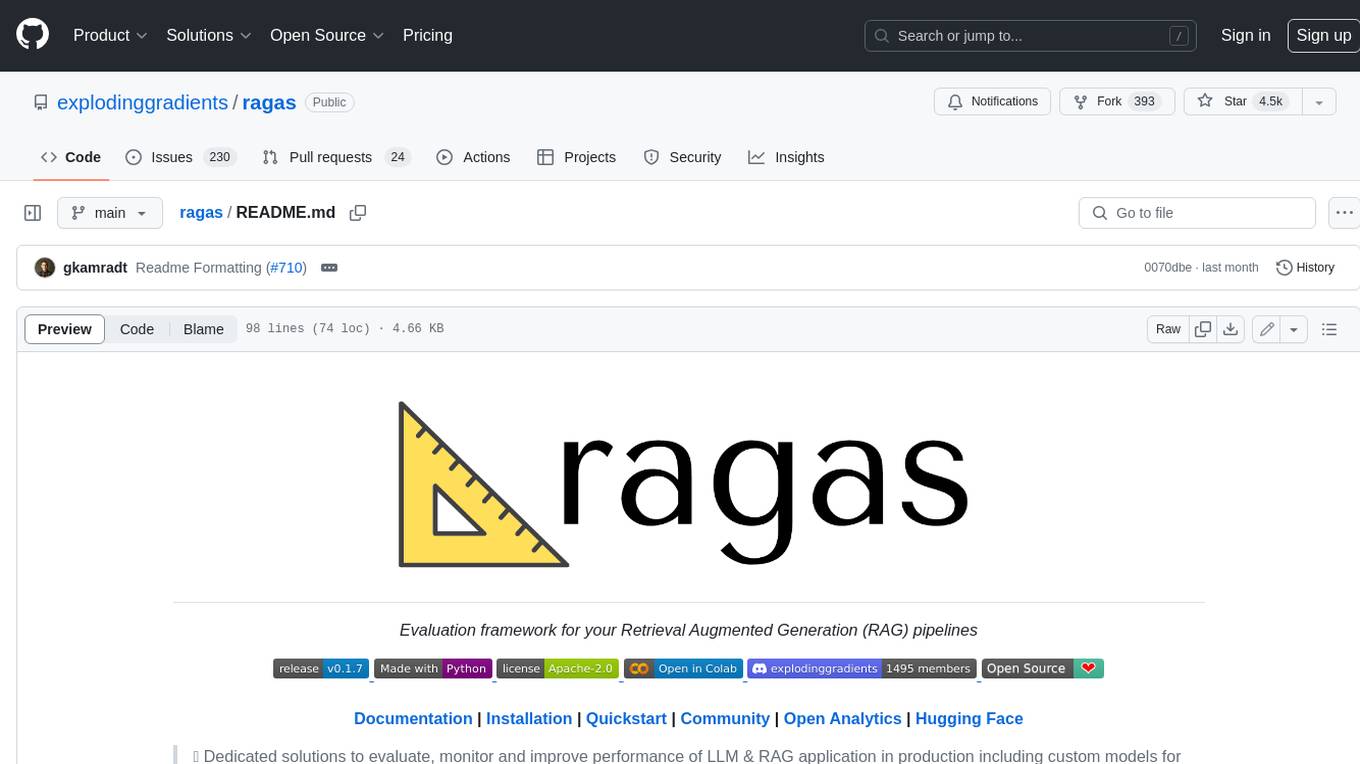
ragas
Ragas is a framework that helps you evaluate your Retrieval Augmented Generation (RAG) pipelines. RAG denotes a class of LLM applications that use external data to augment the LLM’s context. There are existing tools and frameworks that help you build these pipelines but evaluating it and quantifying your pipeline performance can be hard. This is where Ragas (RAG Assessment) comes in. Ragas provides you with the tools based on the latest research for evaluating LLM-generated text to give you insights about your RAG pipeline. Ragas can be integrated with your CI/CD to provide continuous checks to ensure performance.
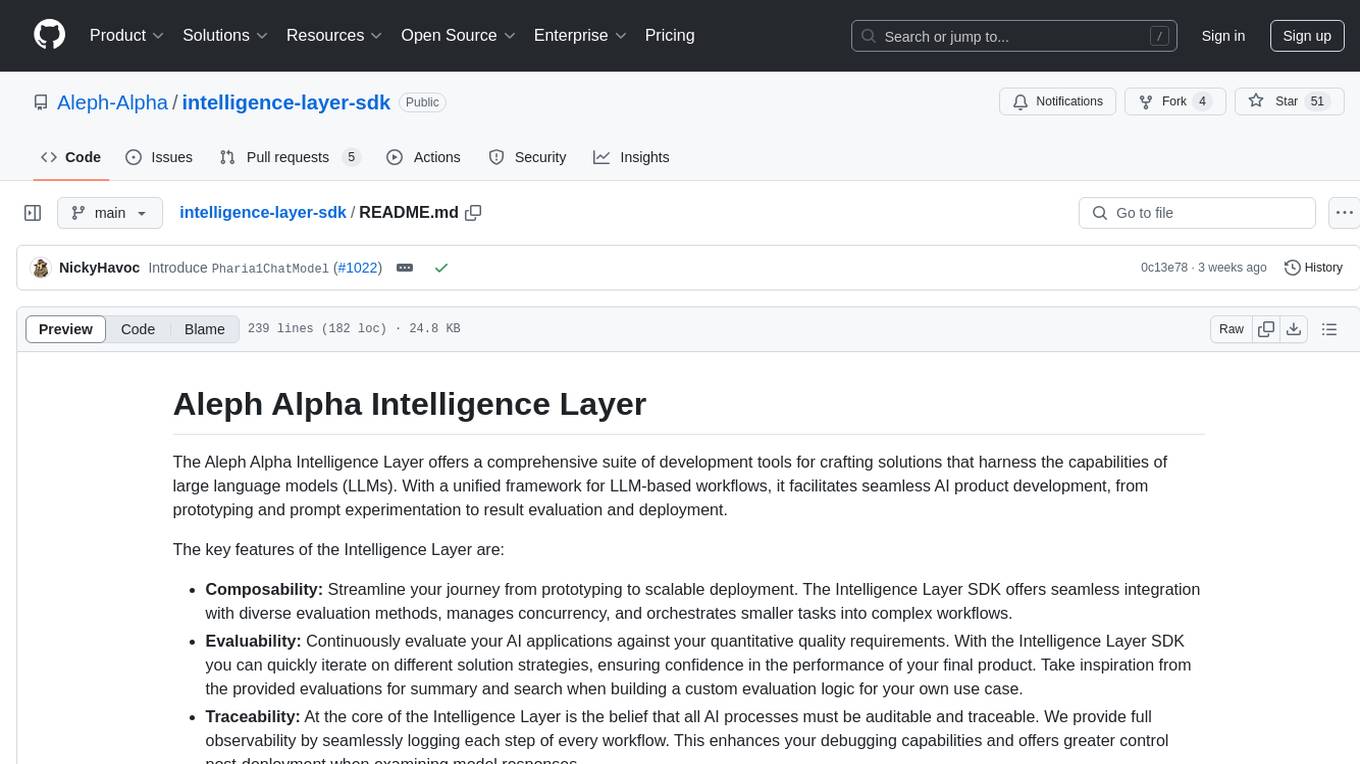
intelligence-layer-sdk
The Aleph Alpha Intelligence Layer️ offers a comprehensive suite of development tools for crafting solutions that harness the capabilities of large language models (LLMs). With a unified framework for LLM-based workflows, it facilitates seamless AI product development, from prototyping and prompt experimentation to result evaluation and deployment. The Intelligence Layer SDK provides features such as Composability, Evaluability, and Traceability, along with examples to get started. It supports local installation using poetry, integration with Docker, and access to LLM endpoints for tutorials and tasks like Summarization, Question Answering, Classification, Evaluation, and Parameter Optimization. The tool also offers pre-configured tasks for tasks like Classify, QA, Search, and Summarize, serving as a foundation for custom development.
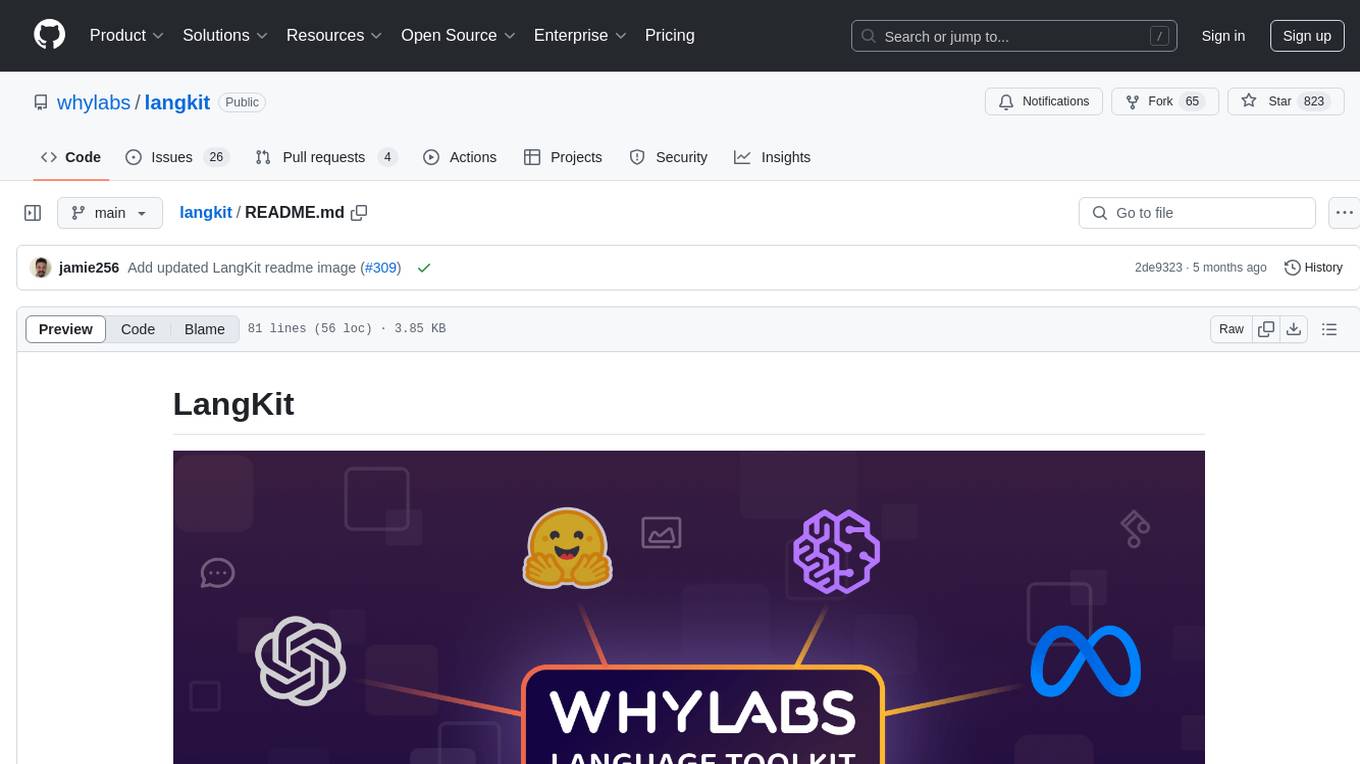
langkit
LangKit is an open-source text metrics toolkit for monitoring language models. It offers methods for extracting signals from input/output text, compatible with whylogs. Features include text quality, relevance, security, sentiment, toxicity analysis. Installation via PyPI. Modules contain UDFs for whylogs. Benchmarks show throughput on AWS instances. FAQs available.
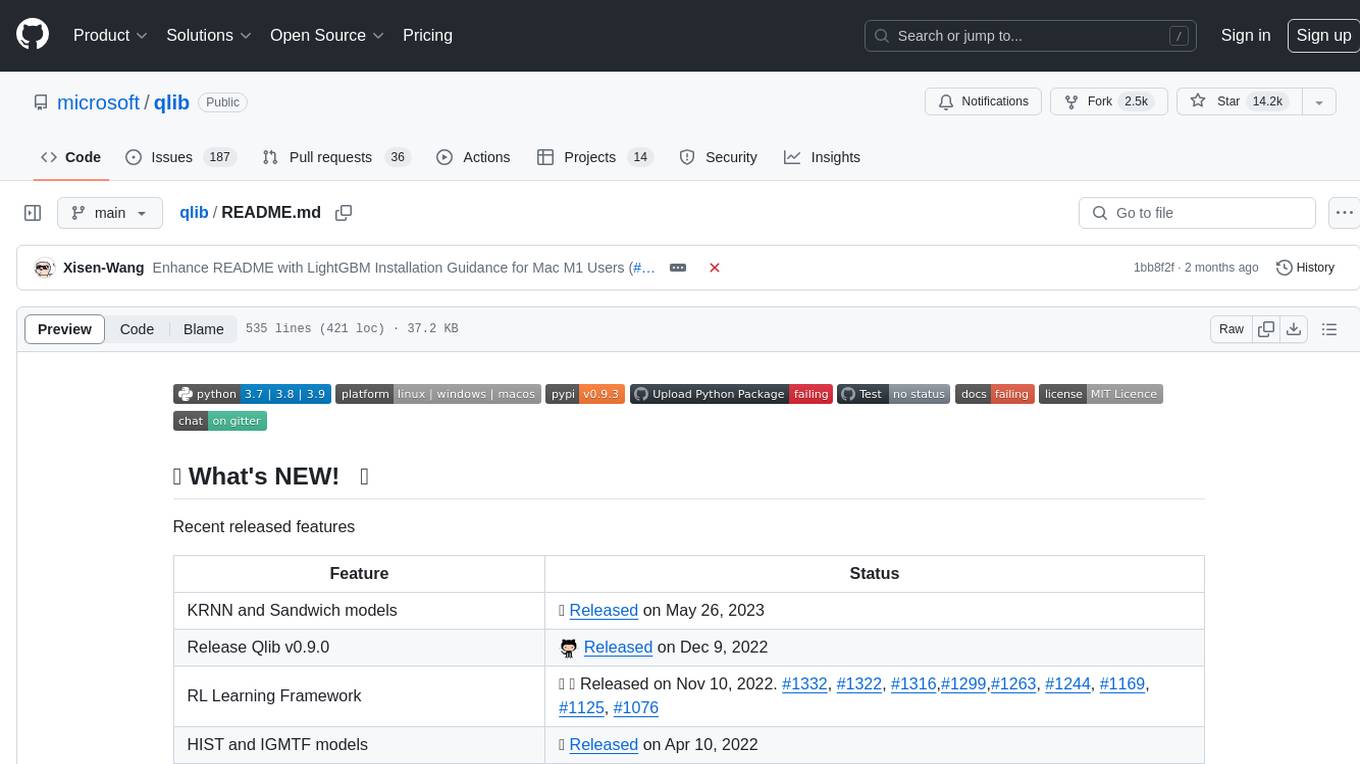
qlib
Qlib is an open-source, AI-oriented quantitative investment platform that supports diverse machine learning modeling paradigms, including supervised learning, market dynamics modeling, and reinforcement learning. It covers the entire chain of quantitative investment, from alpha seeking to order execution. The platform empowers researchers to explore ideas and implement productions using AI technologies in quantitative investment. Qlib collaboratively solves key challenges in quantitative investment by releasing state-of-the-art research works in various paradigms. It provides a full ML pipeline for data processing, model training, and back-testing, enabling users to perform tasks such as forecasting market patterns, adapting to market dynamics, and modeling continuous investment decisions.
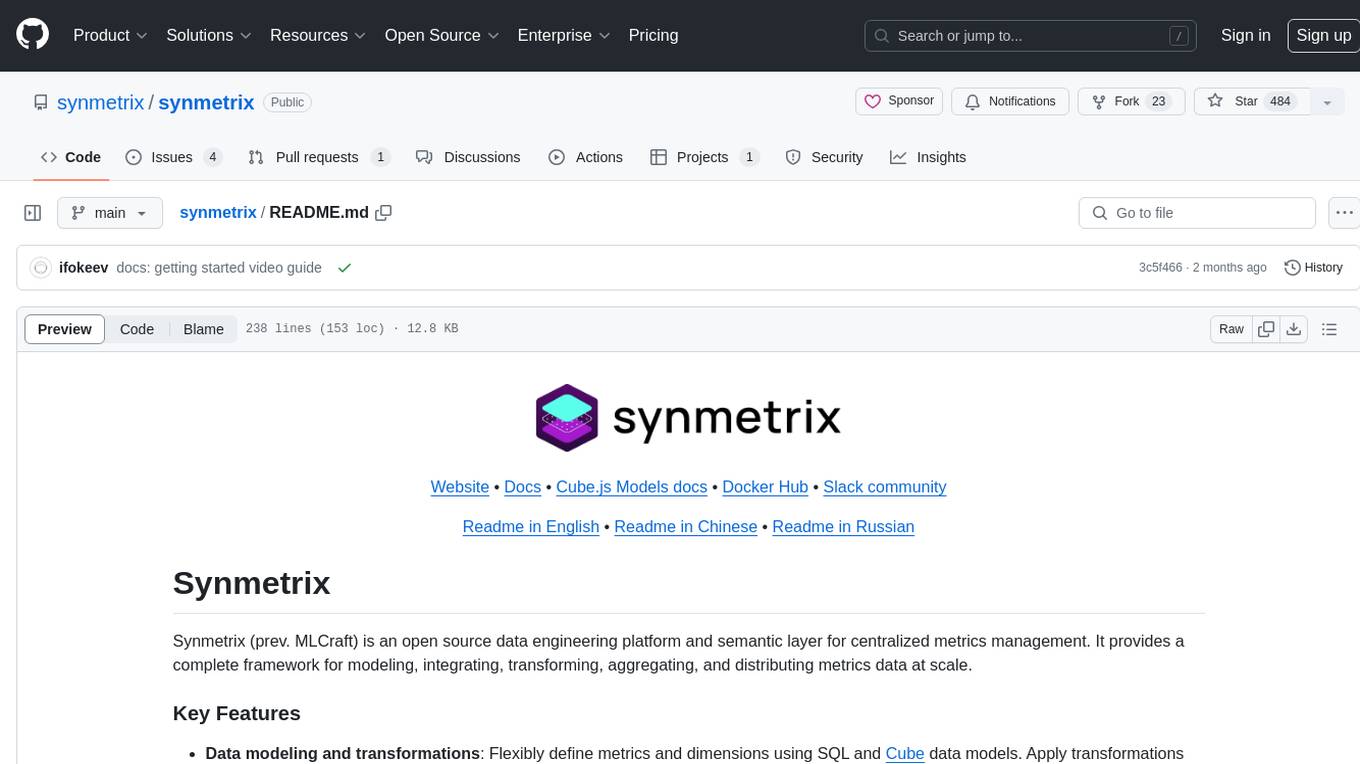
synmetrix
Synmetrix is an open source data engineering platform and semantic layer for centralized metrics management. It provides a complete framework for modeling, integrating, transforming, aggregating, and distributing metrics data at scale. Key features include data modeling and transformations, semantic layer for unified data model, scheduled reports and alerts, versioning, role-based access control, data exploration, caching, and collaboration on metrics modeling. Synmetrix leverages Cube.js to consolidate metrics from various sources and distribute them downstream via a SQL API. Use cases include data democratization, business intelligence and reporting, embedded analytics, and enhancing accuracy in data handling and queries. The tool speeds up data-driven workflows from metrics definition to consumption by combining data engineering best practices with self-service analytics capabilities.
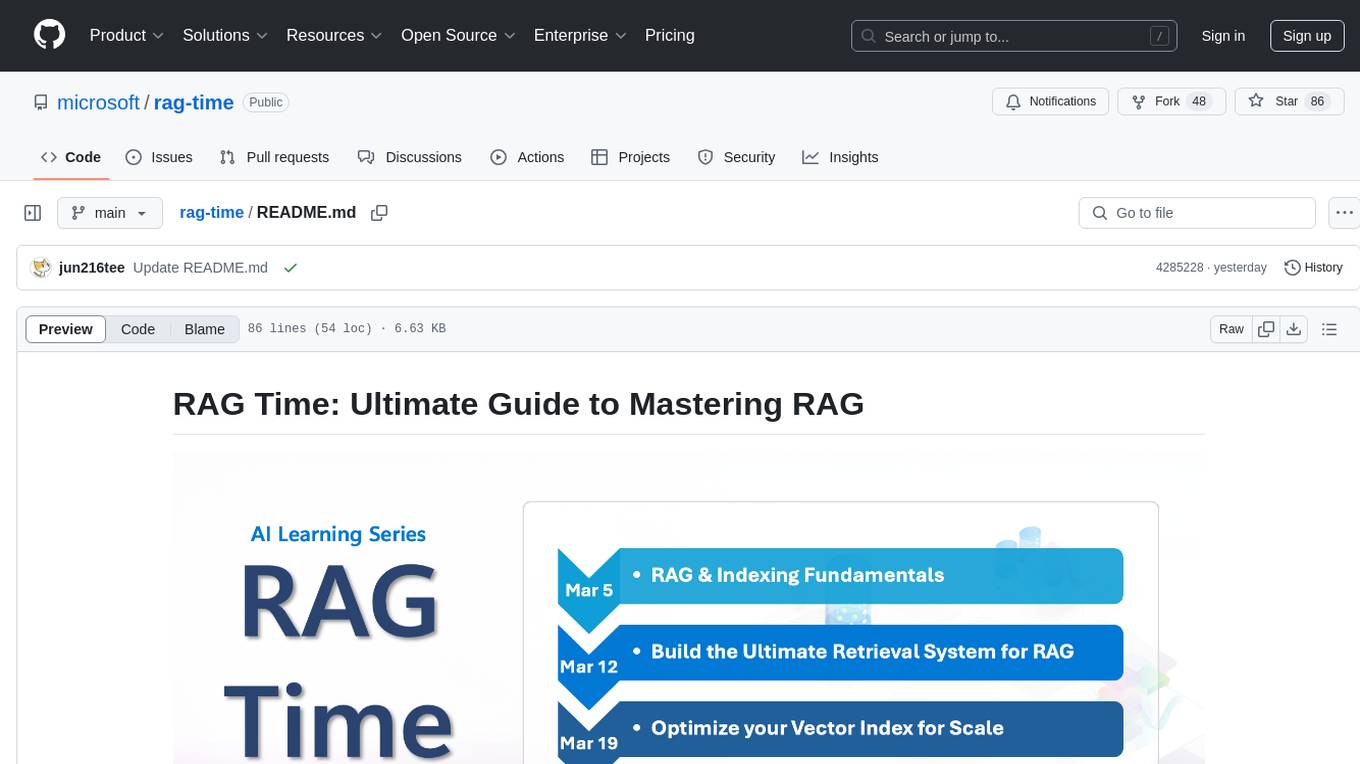
rag-time
RAG Time is a 5-week AI learning series focusing on Retrieval-Augmented Generation (RAG) concepts. The repository contains code samples, step-by-step guides, and resources to help users master RAG. It aims to teach foundational and advanced RAG concepts, demonstrate real-world applications, and provide hands-on samples for practical implementation.
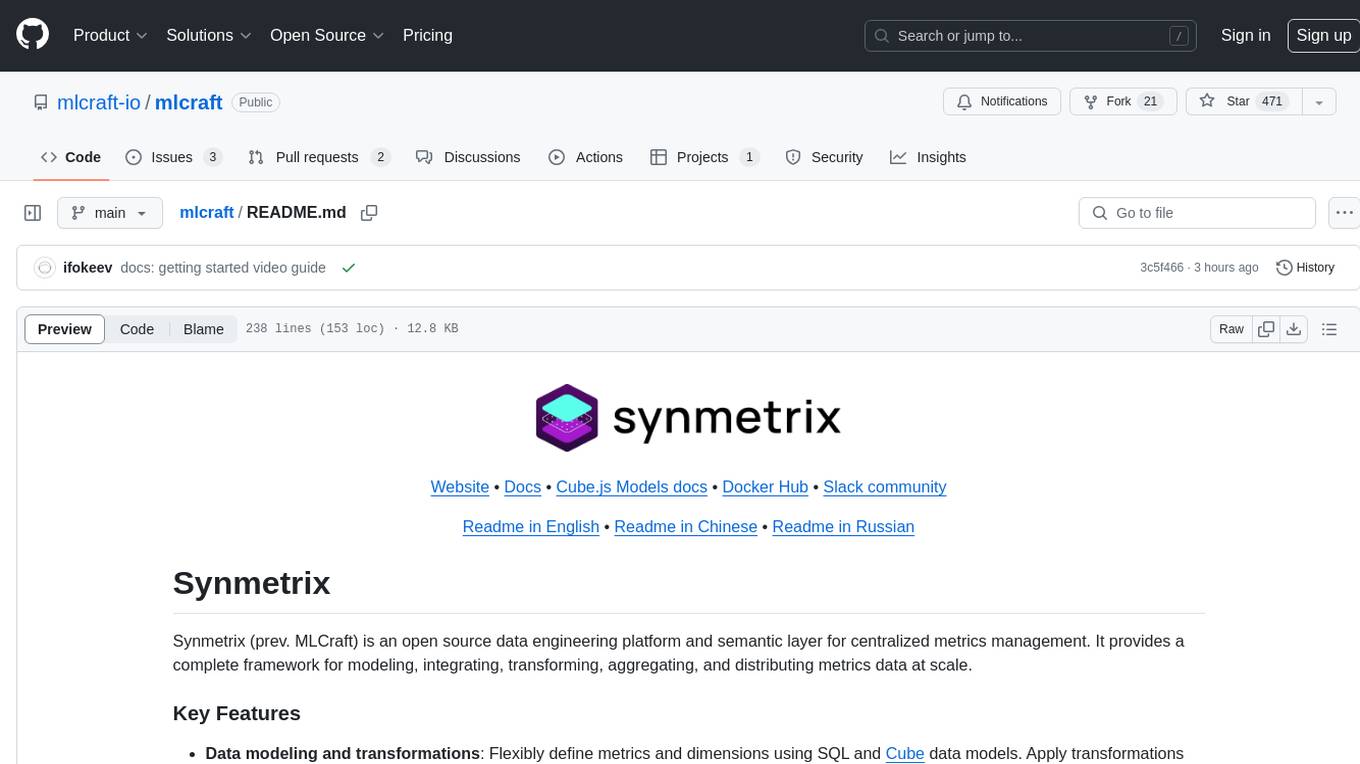
mlcraft
Synmetrix (prev. MLCraft) is an open source data engineering platform and semantic layer for centralized metrics management. It provides a complete framework for modeling, integrating, transforming, aggregating, and distributing metrics data at scale. Key features include data modeling and transformations, semantic layer for unified data model, scheduled reports and alerts, versioning, role-based access control, data exploration, caching, and collaboration on metrics modeling. Synmetrix leverages Cube (Cube.js) for flexible data models that consolidate metrics from various sources, enabling downstream distribution via a SQL API for integration into BI tools, reporting, dashboards, and data science. Use cases include data democratization, business intelligence, embedded analytics, and enhancing accuracy in data handling and queries. The tool speeds up data-driven workflows from metrics definition to consumption by combining data engineering best practices with self-service analytics capabilities.
For similar tasks

ProactiveAgent
Proactive Agent is a project aimed at constructing a fully active agent that can anticipate user's requirements and offer assistance without explicit requests. It includes a data collection and generation pipeline, automatic evaluator, and training agent. The project provides datasets, evaluation scripts, and prompts to finetune LLM for proactive agent. Features include environment sensing, assistance annotation, dynamic data generation, and construction pipeline with a high F1 score on the test set. The project is intended for coding, writing, and daily life scenarios, distributed under Apache License 2.0.
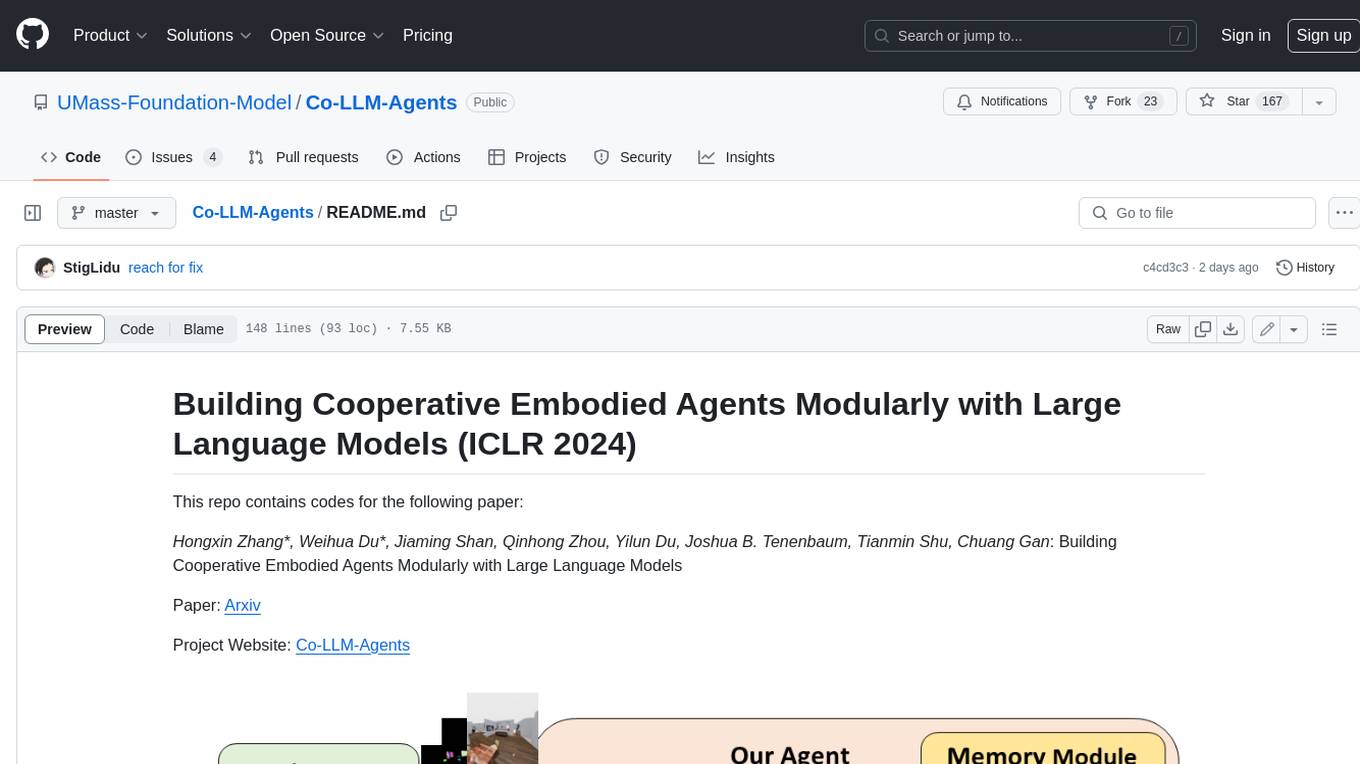
Co-LLM-Agents
This repository contains code for building cooperative embodied agents modularly with large language models. The agents are trained to perform tasks in two different environments: ThreeDWorld Multi-Agent Transport (TDW-MAT) and Communicative Watch-And-Help (C-WAH). TDW-MAT is a multi-agent environment where agents must transport objects to a goal position using containers. C-WAH is an extension of the Watch-And-Help challenge, which enables agents to send messages to each other. The code in this repository can be used to train agents to perform tasks in both of these environments.
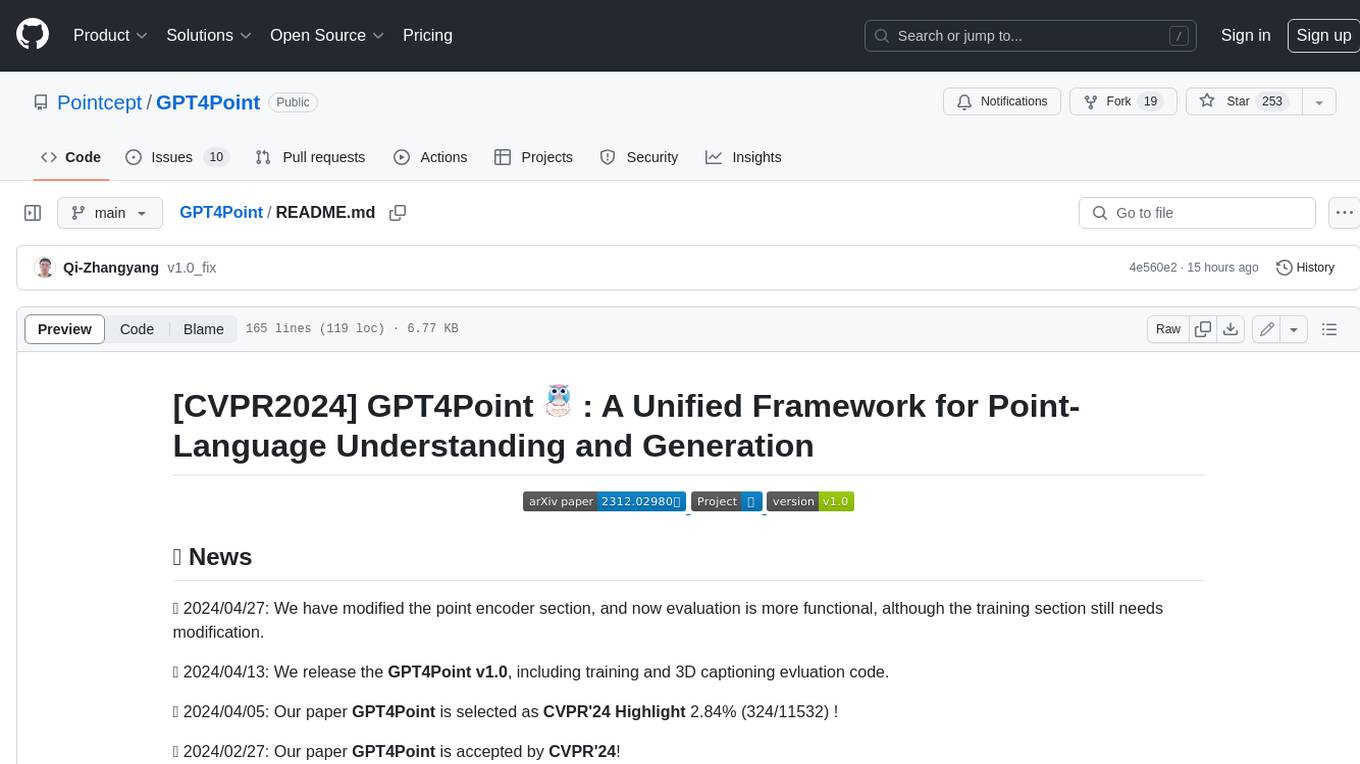
GPT4Point
GPT4Point is a unified framework for point-language understanding and generation. It aligns 3D point clouds with language, providing a comprehensive solution for tasks such as 3D captioning and controlled 3D generation. The project includes an automated point-language dataset annotation engine, a novel object-level point cloud benchmark, and a 3D multi-modality model. Users can train and evaluate models using the provided code and datasets, with a focus on improving models' understanding capabilities and facilitating the generation of 3D objects.
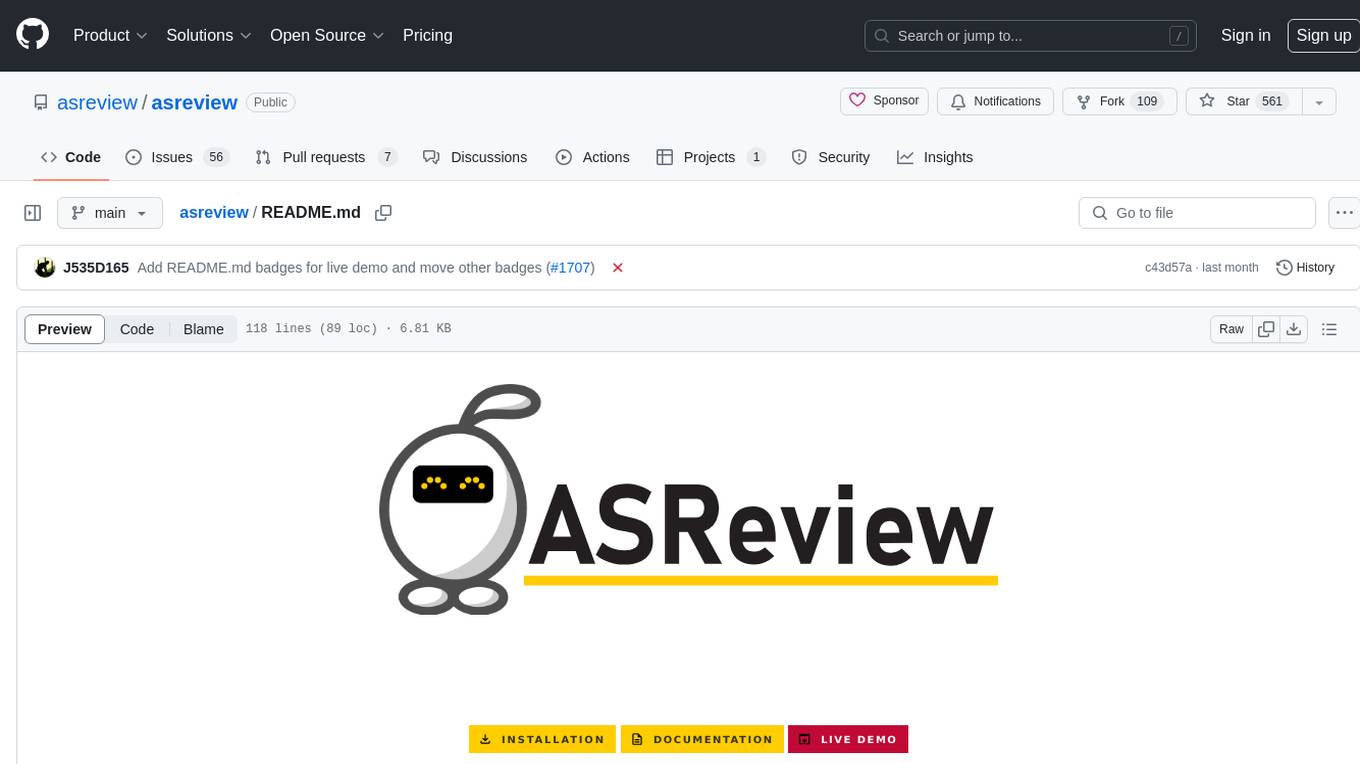
asreview
The ASReview project implements active learning for systematic reviews, utilizing AI-aided pipelines to assist in finding relevant texts for search tasks. It accelerates the screening of textual data with minimal human input, saving time and increasing output quality. The software offers three modes: Oracle for interactive screening, Exploration for teaching purposes, and Simulation for evaluating active learning models. ASReview LAB is designed to support decision-making in any discipline or industry by improving efficiency and transparency in screening large amounts of textual data.
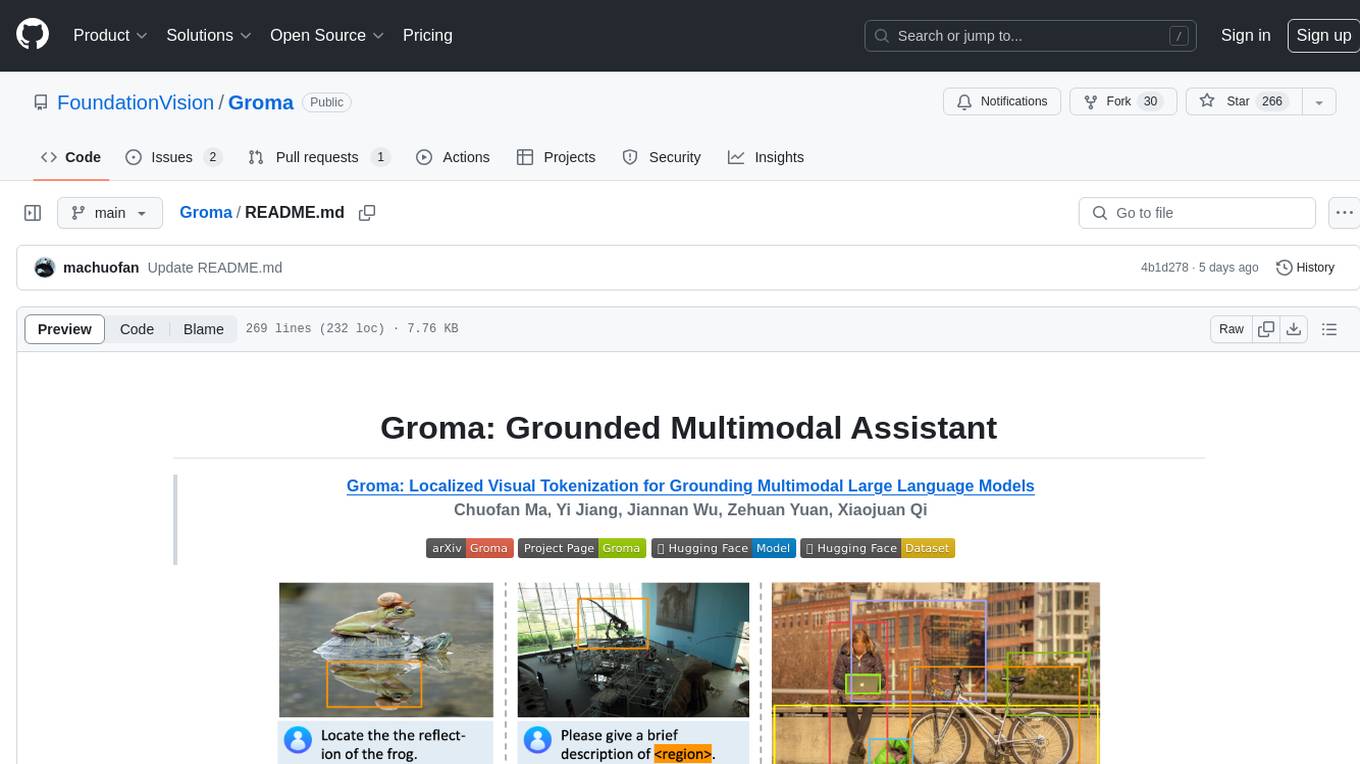
Groma
Groma is a grounded multimodal assistant that excels in region understanding and visual grounding. It can process user-defined region inputs and generate contextually grounded long-form responses. The tool presents a unique paradigm for multimodal large language models, focusing on visual tokenization for localization. Groma achieves state-of-the-art performance in referring expression comprehension benchmarks. The tool provides pretrained model weights and instructions for data preparation, training, inference, and evaluation. Users can customize training by starting from intermediate checkpoints. Groma is designed to handle tasks related to detection pretraining, alignment pretraining, instruction finetuning, instruction following, and more.
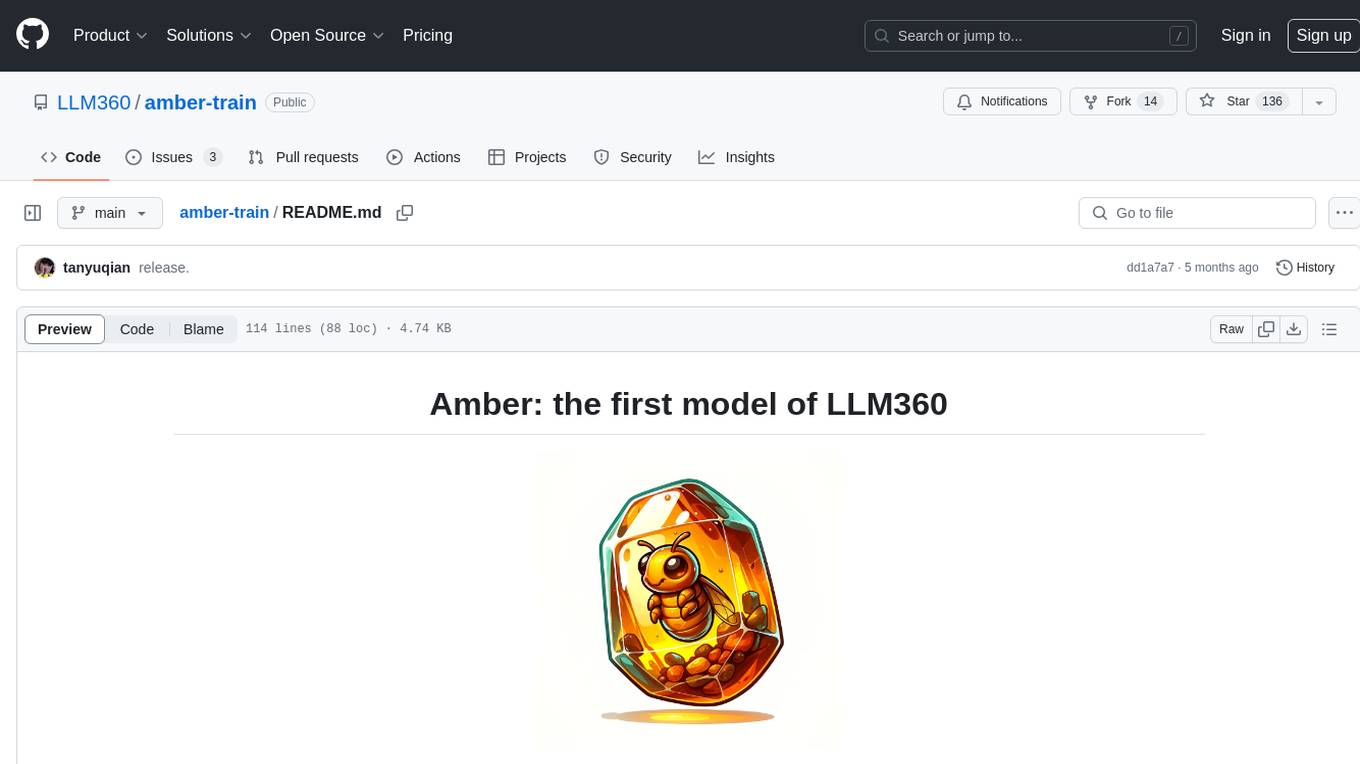
amber-train
Amber is the first model in the LLM360 family, an initiative for comprehensive and fully open-sourced LLMs. It is a 7B English language model with the LLaMA architecture. The model type is a language model with the same architecture as LLaMA-7B. It is licensed under Apache 2.0. The resources available include training code, data preparation, metrics, and fully processed Amber pretraining data. The model has been trained on various datasets like Arxiv, Book, C4, Refined-Web, StarCoder, StackExchange, and Wikipedia. The hyperparameters include a total of 6.7B parameters, hidden size of 4096, intermediate size of 11008, 32 attention heads, 32 hidden layers, RMSNorm ε of 1e^-6, max sequence length of 2048, and a vocabulary size of 32000.
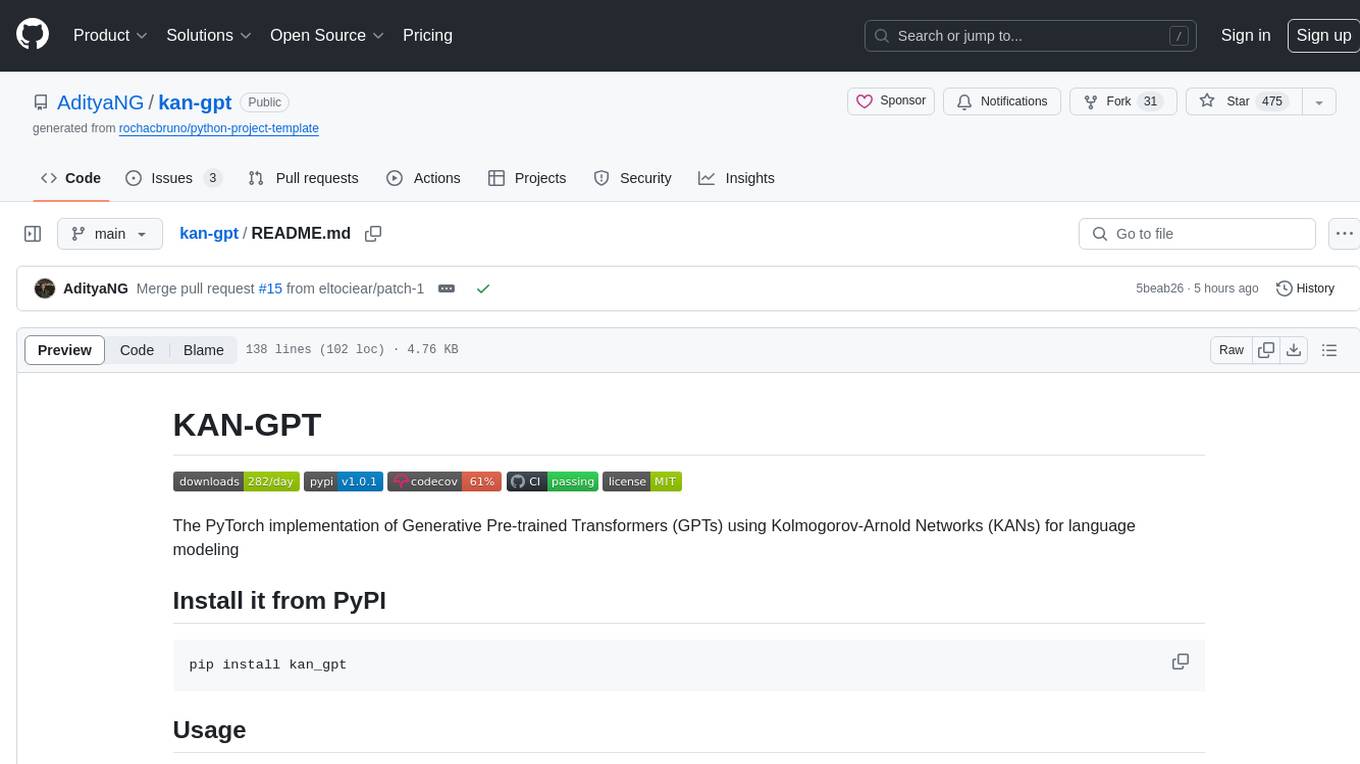
kan-gpt
The KAN-GPT repository is a PyTorch implementation of Generative Pre-trained Transformers (GPTs) using Kolmogorov-Arnold Networks (KANs) for language modeling. It provides a model for generating text based on prompts, with a focus on improving performance compared to traditional MLP-GPT models. The repository includes scripts for training the model, downloading datasets, and evaluating model performance. Development tasks include integrating with other libraries, testing, and documentation.
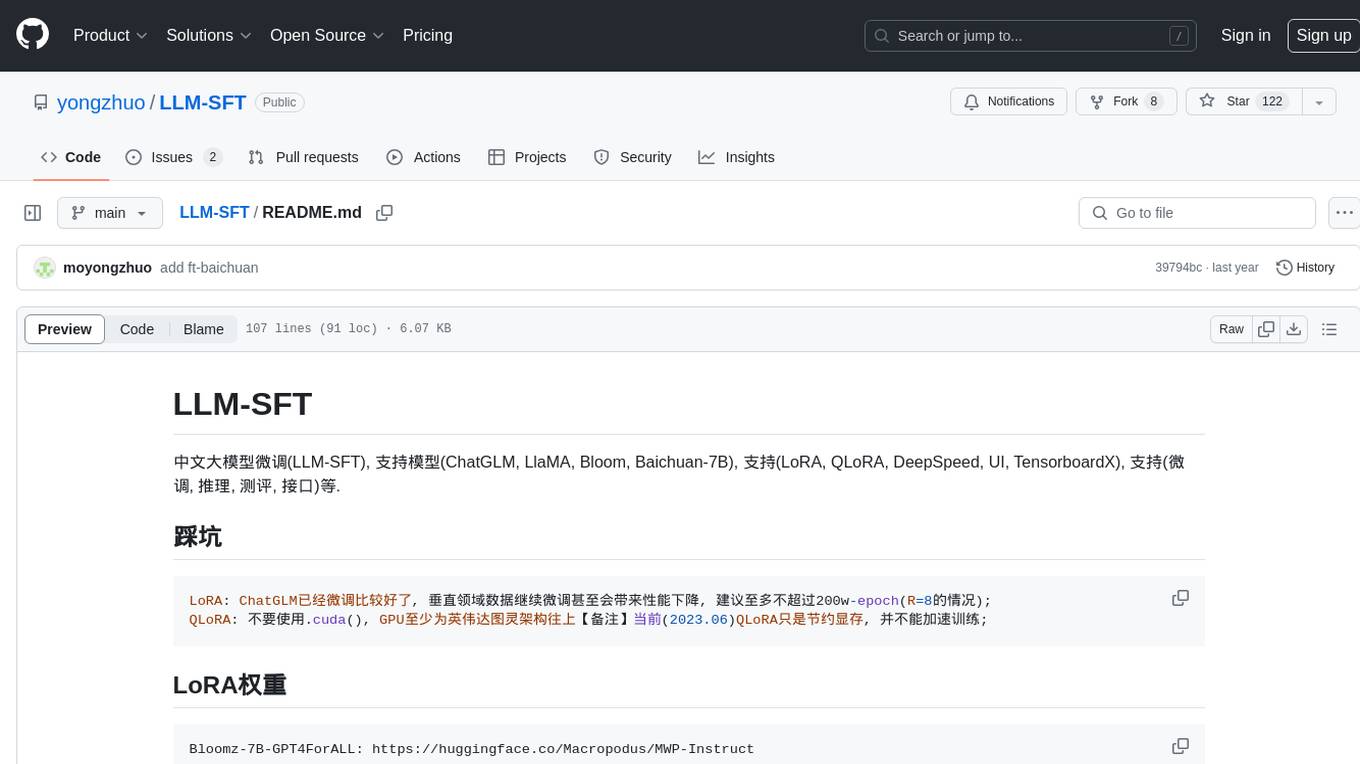
LLM-SFT
LLM-SFT is a Chinese large model fine-tuning tool that supports models such as ChatGLM, LlaMA, Bloom, Baichuan-7B, and frameworks like LoRA, QLoRA, DeepSpeed, UI, and TensorboardX. It facilitates tasks like fine-tuning, inference, evaluation, and API integration. The tool provides pre-trained weights for various models and datasets for Chinese language processing. It requires specific versions of libraries like transformers and torch for different functionalities.
For similar jobs

weave
Weave is a toolkit for developing Generative AI applications, built by Weights & Biases. With Weave, you can log and debug language model inputs, outputs, and traces; build rigorous, apples-to-apples evaluations for language model use cases; and organize all the information generated across the LLM workflow, from experimentation to evaluations to production. Weave aims to bring rigor, best-practices, and composability to the inherently experimental process of developing Generative AI software, without introducing cognitive overhead.

LLMStack
LLMStack is a no-code platform for building generative AI agents, workflows, and chatbots. It allows users to connect their own data, internal tools, and GPT-powered models without any coding experience. LLMStack can be deployed to the cloud or on-premise and can be accessed via HTTP API or triggered from Slack or Discord.

VisionCraft
The VisionCraft API is a free API for using over 100 different AI models. From images to sound.

kaito
Kaito is an operator that automates the AI/ML inference model deployment in a Kubernetes cluster. It manages large model files using container images, avoids tuning deployment parameters to fit GPU hardware by providing preset configurations, auto-provisions GPU nodes based on model requirements, and hosts large model images in the public Microsoft Container Registry (MCR) if the license allows. Using Kaito, the workflow of onboarding large AI inference models in Kubernetes is largely simplified.

PyRIT
PyRIT is an open access automation framework designed to empower security professionals and ML engineers to red team foundation models and their applications. It automates AI Red Teaming tasks to allow operators to focus on more complicated and time-consuming tasks and can also identify security harms such as misuse (e.g., malware generation, jailbreaking), and privacy harms (e.g., identity theft). The goal is to allow researchers to have a baseline of how well their model and entire inference pipeline is doing against different harm categories and to be able to compare that baseline to future iterations of their model. This allows them to have empirical data on how well their model is doing today, and detect any degradation of performance based on future improvements.

tabby
Tabby is a self-hosted AI coding assistant, offering an open-source and on-premises alternative to GitHub Copilot. It boasts several key features: * Self-contained, with no need for a DBMS or cloud service. * OpenAPI interface, easy to integrate with existing infrastructure (e.g Cloud IDE). * Supports consumer-grade GPUs.

spear
SPEAR (Simulator for Photorealistic Embodied AI Research) is a powerful tool for training embodied agents. It features 300 unique virtual indoor environments with 2,566 unique rooms and 17,234 unique objects that can be manipulated individually. Each environment is designed by a professional artist and features detailed geometry, photorealistic materials, and a unique floor plan and object layout. SPEAR is implemented as Unreal Engine assets and provides an OpenAI Gym interface for interacting with the environments via Python.

Magick
Magick is a groundbreaking visual AIDE (Artificial Intelligence Development Environment) for no-code data pipelines and multimodal agents. Magick can connect to other services and comes with nodes and templates well-suited for intelligent agents, chatbots, complex reasoning systems and realistic characters.

